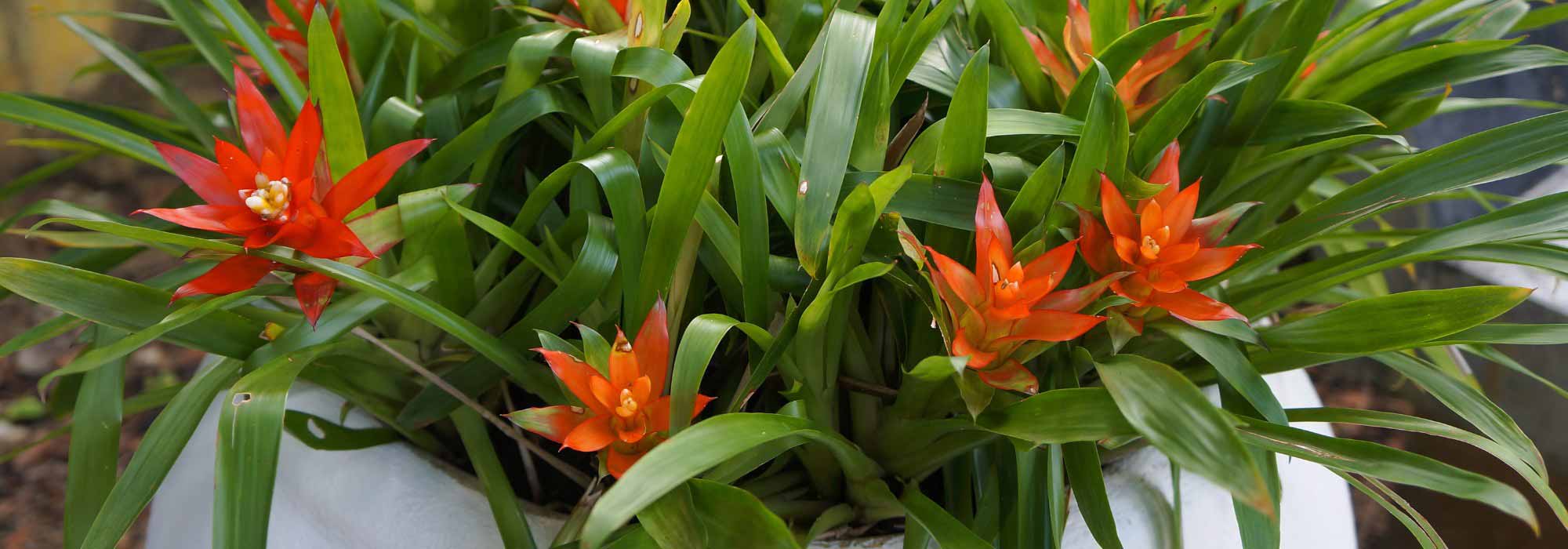
Guzmania: care, planting, and advice
Contents
Guzmania in a nutshell
- This is a perennial plant from the humid forests of Central and South America, perfectly suited for indoor cultivation.
- The Guzmania forms a rosette of ribbon-like, flexible, and glossy leaves.
- It offers a long flowering period with colourful bracts surrounding small, inconspicuous flowers.
- It requires minimal care and enjoys moderate watering and exposure to indirect light.
- Its underdeveloped root system demands a light, well-draining compost to prevent water stagnation.
- It is ideal for warm, humid rooms such as bathrooms or bright conservatories.
The word from our expert
The Guzmania is a remarkable tropical plant belonging to the Bromeliaceae family, cultivated in our climate as a houseplant. It is prized for its decorative foliage and spectacular exotic flowering. Native to the humid forests of Central and South America, it adapts perfectly to indoor cultivation due to its moderate light requirements and ability to thrive in warm, humid environments.
With nearly 120 to 200 species, the Guzmania offers a great diversity of forms and colours. Some species, such as the Guzmania lingulata with its striking red bracts or the Guzmania conifera with its orange conical inflorescences, are particularly sought after for their unique aesthetics. Its rosette habit, colourful bracts, and air-purifying abilities make it an ideal plant for adding a tropical touch to a bright living room, a humid bathroom, or a heated conservatory. Discover this vibrant, low-maintenance plant!
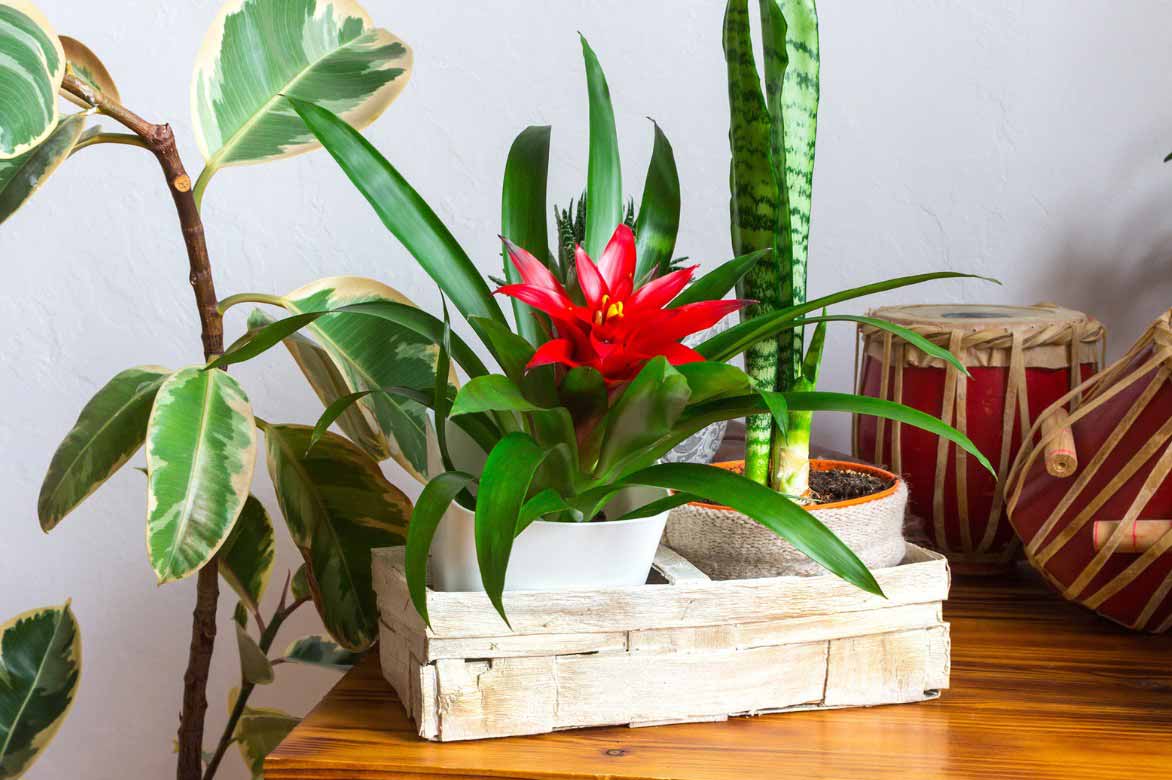
Botany and description
Botanical data
- Latin name Guzmania
- Family Bromeliaceae (Bromeliads)
- Common name Guzmania, Guzmán's Bromeliad
- Flowering From spring to summer
- Height Between 30 and 60 cm
- Exposure Bright
- Soil type Light, well-draining and airy substrate
- Hardiness Frost-sensitive
Guzmania is a tropical plant from the Bromeliaceae family, also known as “Guzmán’s Bromeliad”. The genus includes around 120 species, characterised by their rosettes of leaves and colourful inflorescences, often cone- or spike-shaped, offering a dazzling display.
The Guzmania lingulata is undoubtedly the most emblematic species of the Guzmania genus. Its specific name lingulata refers to the shape of its leaves, resembling a tongue (lingua in Latin), elongated, flexible, and slightly arched. This plant captivates with its spectacular bracts, in flamboyant hues ranging from bright red to orange, with shades of yellow and pink. Thanks to its popularity, the Guzmania lingulata has given rise to numerous cultivars with varied shapes and colours, specially created to enrich indoor plant collections. Among them are:
- ‘Indian Night’: characterised by deep red bracts, almost burgundy, bringing a warm and elegant ambiance.
- ‘Akabar’: remarkable for its intense red bracts, sometimes verging on scarlet, creating a striking contrast with its glossy green foliage.
- ‘Alerta‘: with bright orange bracts, offering a luminous and vibrant touch, perfect for energising an interior.
- ‘Calypso‘: known for its golden yellow or orange tones, bringing a softer, exotic note.
You may also encounter Guzmania conifera in nurseries, recognisable by its conical inflorescence, very original, resembling a pine cone.
In its natural habitat, Guzmania thrives in the humid tropical forests of Central and South America, stretching from Costa Rica to Ecuador and even the Amazon. It is a perennial plant that typically grows as an epiphyte, clinging to tree branches, benefiting from filtered light and ambient humidity without ever parasitising its host. This lifestyle allows it to flourish in warm, humid environments, characteristic of these regions.
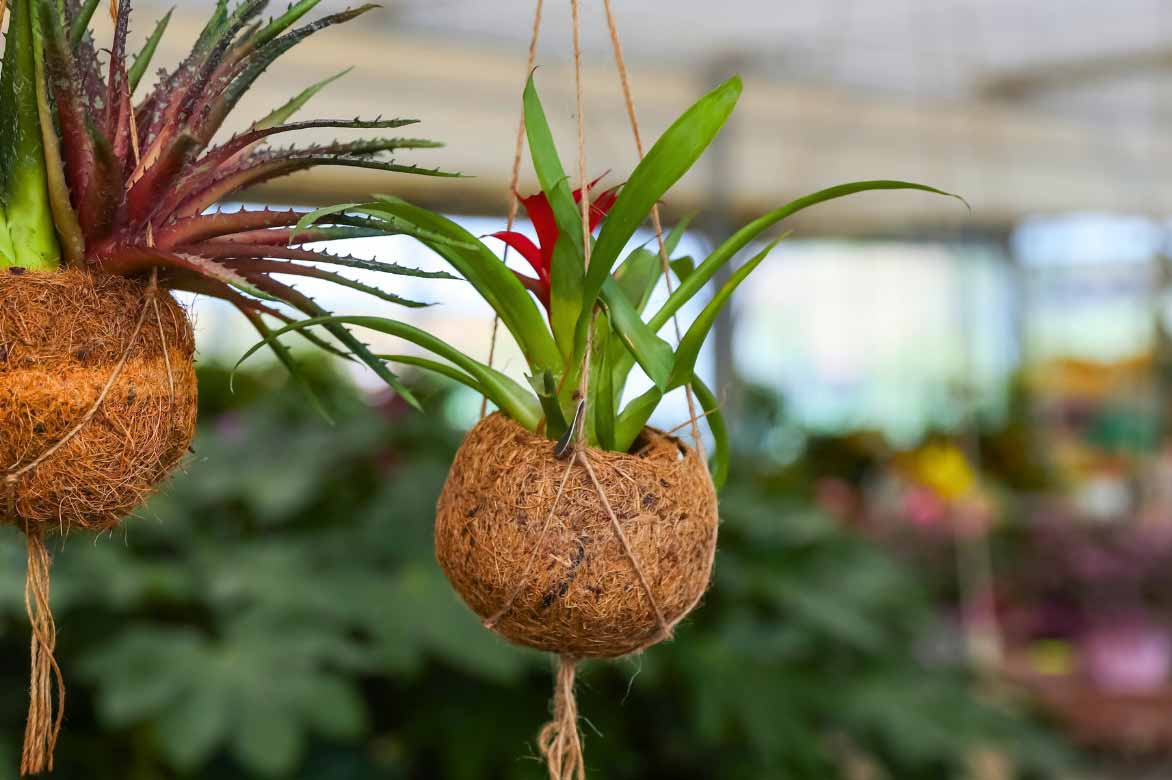
Guzmania boasts an elegant and exotic silhouette. Its habit is a compact rosette, formed by long, ribbon-like, flexible leaves that spread harmoniously. This natural arrangement creates a kind of funnel at the centre of the plant, called the central rosette, which serves to capture water and nutrients in its tropical environment.
Its root system is underdeveloped and shallow. The roots of Guzmania mainly serve to anchor the plant to its support, especially when it grows as an epiphyte on trees in the wild. They absorb few nutrients from the soil, explaining its need for a very light and well-draining substrate.
The foliage of Guzmania is flexible, smooth, and glossy, with green leaves that may sometimes be slightly tinged with red or purple on the underside. These leaves can measure between 30 and 60 cm in length depending on the species, and their leathery texture helps limit water evaporation.
The most spectacular element remains its inflorescence, often mistaken for a flower. This floral spike, about 30 cm tall, is composed of colourful bracts—red, yellow, orange, or pink—surrounding small, discreet, tubular flowers, which last only 24 hours. This inflorescence emerges from the centre of the rosette and can last for several months, adding a vibrant, tropical touch. Guzmania is a semelparous plant, meaning it flowers only once before dying. The mother plant lives for 3 to 4 years. However, during this time, it will have produced offsets, allowing it to multiply naturally.
Guzmania, like many bromeliads, helps improve indoor air quality. Thanks to its rosette structure, it captures humidity and absorbs certain pollutants present in the air, helping to create a healthier environment. This ability to regulate humidity and filter toxins makes it an interesting indoor plant for confined spaces.
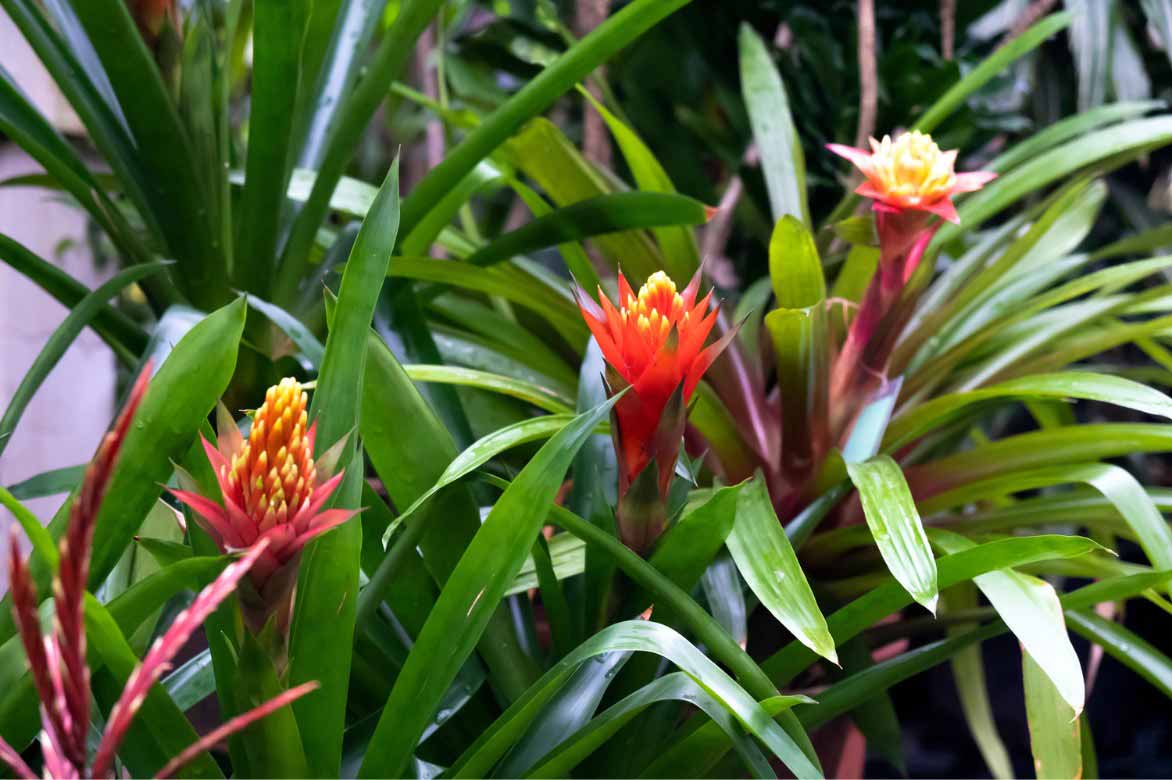
Main species and varieties
Guzmania Indian Night
Guzmania Akabar
Guzmania Alerta
Guzmania Calypso
Guzmania Filou
Guzmania Candy
Guzmania Flava
Guzmania Limones
Guzmania Loja
Guzmania Max
Guzmania Melissa
Planting Guzmania Indoors
Where to Place the Guzmania Indoors?
This tropical plant requires a stable environment with temperatures ideally between 18°C and 25°C (never below 13°C) and good ambient humidity to thrive fully. A bright spot, free from drafts and away from radiators, is the perfect location to encourage its growth. Place it indoors or in a bright conservatory, as it enjoys warm and humid environments. Opt for a spot with indirect or filtered light. Avoid direct sunlight, which could scorch its leaves. A space with good ambient humidity, such as a bright bathroom, is ideal.
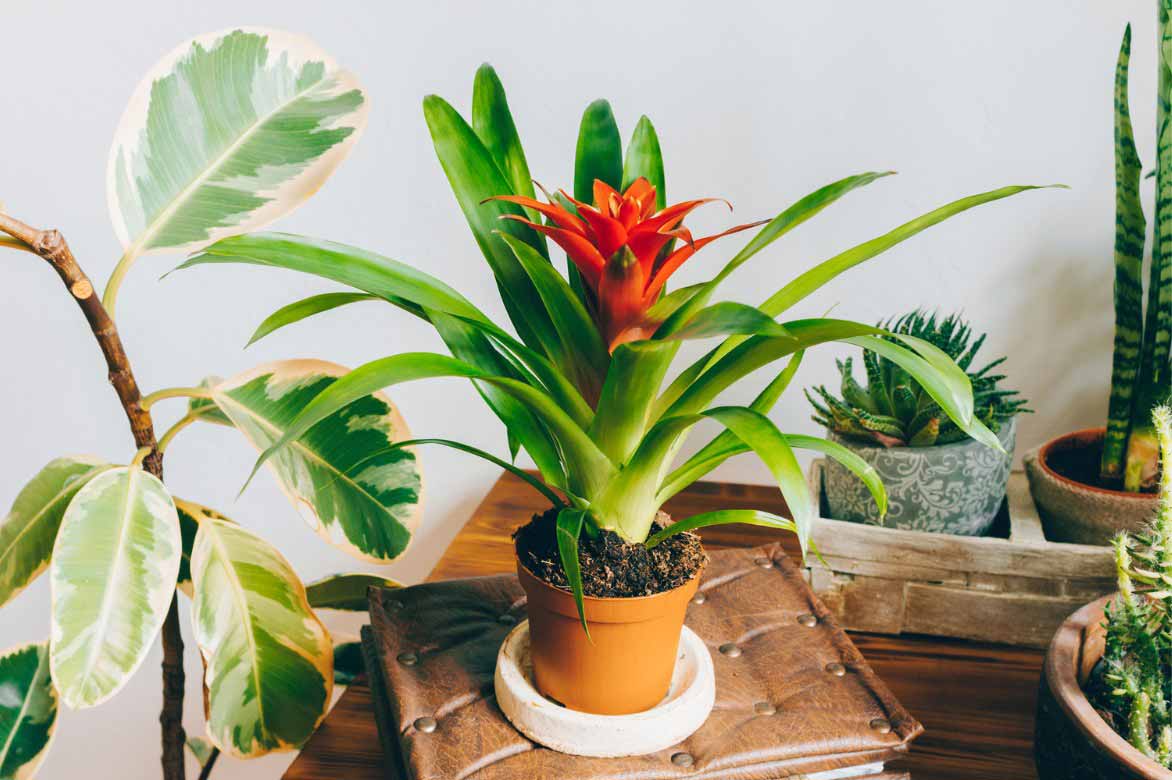
When to Plant a Guzmania?
The Guzmania can be planted, or more accurately repotted, year-round indoors, provided it is given suitable conditions. The environment should remain relatively warm (between 18°C and 25°C), and the air should be sufficiently humid. However, spring and early summer are the ideal periods, as the plant is in an active growth phase, making it easier to adapt to a new pot or substrate. In autumn and winter, ensure to compensate for the lack of light and avoid cold drafts.
How to Plant a Guzmania?
- Choose a pot with drainage holes to ensure good drainage, as stagnant water can cause root rot.
- Fill the pot with a light and well-draining substrate, such as orchid compost or a mix of compost with sphagnum moss and perlite.
- Place the plant gently in the centre of the pot without burying the central rosette, as it needs to remain exposed to capture water.
- Fill around the roots with the substrate, lightly firming it to stabilise the plant.
- Water by pouring water directly into the central rosette, without soaking the compost.
- Maintain an ambient temperature between 18°C and 25°C to encourage its growth.
- Mist the leaves regularly with non-calcareous water to recreate its tropical environment.
How to properly care for a Guzmania?
The care of the Guzmania is straightforward and undemanding, provided its tropical origins are respected. Watering should remain moderate: in summer, a weekly watering is sufficient, while in winter, it can be spaced out to every two weeks. Water, preferably non-calcareous such as rainwater or filtered water, should be poured directly into the central rosette, as this is how the plant hydrates. It is important to empty and refresh this water regularly to prevent stagnation and avoid the risk of mould. The substrate should remain slightly moist but never waterlogged to prevent root rot. Never leave water in the saucer.
The Guzmania does not require specific pruning. Simply remove any wilted or damaged leaves at the base to keep the plant tidy and encourage its growth. Once flowering is over, the inflorescence can be cut close to the base to maintain an attractive plant and prevent it from exhausting itself by producing seeds.
This plant thrives in warm and humid environments, with an ideal temperature between 18°C and 25°C. Regular humidity, particularly through spraying non-calcareous water on the leaves, is recommended, especially in winter when indoor air is drier. It should also be kept away from drafts and direct heat sources such as radiators.
It is also important to regularly dust the leaves of the Guzmania to preserve its health and shine. Dust accumulating on the leaves can hinder photosynthesis and reduce its ability to absorb ambient humidity. To clean the foliage, simply wipe the leaves gently with a damp cloth or soft sponge.
Finally, during the growth period, from spring to summer, a monthly application of liquid fertiliser (orchid fertiliser) diluted directly into the rosette or during watering promotes its development. However, adding fertiliser is unnecessary in autumn and winter, periods when the plant naturally slows its growth.
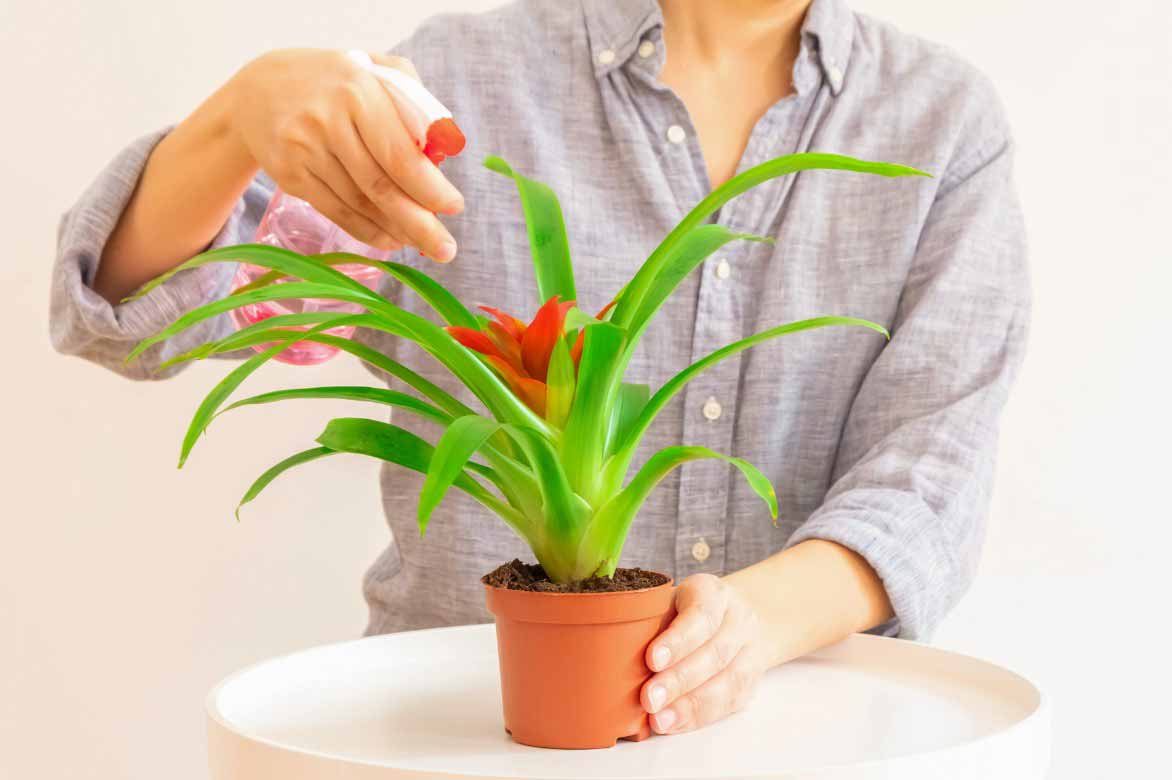
How to Cut the Faded Flower of the Guzmania?
Cutting the faded flower of the Guzmania is recommended to prolong the life of the mother plant. Once flowering is over, the colourful bracts begin to dry out and gradually lose their shine. It is then advisable to cut the flower stem as close to the base as possible, using clean and sharp pruning shears. This cut allows the plant to focus its energy on producing offsets, the young shoots that will ensure its renewal. Leaving the faded flower in place can exhaust the plant as it produces seeds, slow the emergence of new shoots, and encourage moisture accumulation in the rosette, increasing the risk of mould or rot. By removing the dead part, the plant remains tidy, and its life cycle is naturally extended.
Diseases and potential pests
The Guzmania is generally a resilient plant, but it can sometimes be vulnerable to certain issues. Excess moisture is one of its main enemies, potentially leading to root or central rosette rot, especially if water stagnates. Poorly controlled watering or inadequate drainage can encourage fungal diseases. The plant may also develop brown spots on its leaves, often caused by sunburn from direct exposure or overly dry air.
As for pests, the Guzmania can attract mealybugs, which settle between the leaves and suck the sap, weakening the plant. Aphids and red spider mites may also appear when the air is too dry, causing yellowing or drying of the foliage. To prevent these attacks, it is important to maintain good ambient humidity and regularly inspect the plant to quickly detect any abnormalities.
Multiplication
After flowering, the Guzmania naturally produces offsets (small shoots) at the base of the mother plant. To propagate it, wait until these offsets are at least 10 to 15 cm tall and have a few roots. With a little patience, they will grow into beautiful Guzmanias!
- Use a clean, sharp knife or disinfected pruning shears to avoid contamination.
- Gently remove the mother plant from the pot and detach the offsets by cutting them cleanly at the base. Be careful not to damage the young roots.
- Fill a small pot with a light, well-draining substrate, such as orchid compost or a mix of compost, sphagnum moss, and perlite.
- Plant the offset without burying the central rosette.
- Lightly moisten the substrate and pour a little water into the central rosette. Be careful not to oversaturate the soil.
- Wrap the offset and its pot in a transparent plastic bag to maintain a humid atmosphere and encourage rooting.
- Place the pot in a bright spot, away from direct sunlight, with a temperature around 22 to 25°C (for example, above a radiator) and good ambient humidity.
- Ventilate regularly by opening the bag, water moderately, and mist the leaves regularly. The offsets will take a few weeks to root properly.
Useful resources
- Discover our range of Bromeliads, these exotic young plants, native to tropical regions!
- How to care for houseplants according to the seasons?
- Discover our range of houseplants and flowering indoor plants to bring exoticism and elegance to your home.
- Subscribe!
- Contents
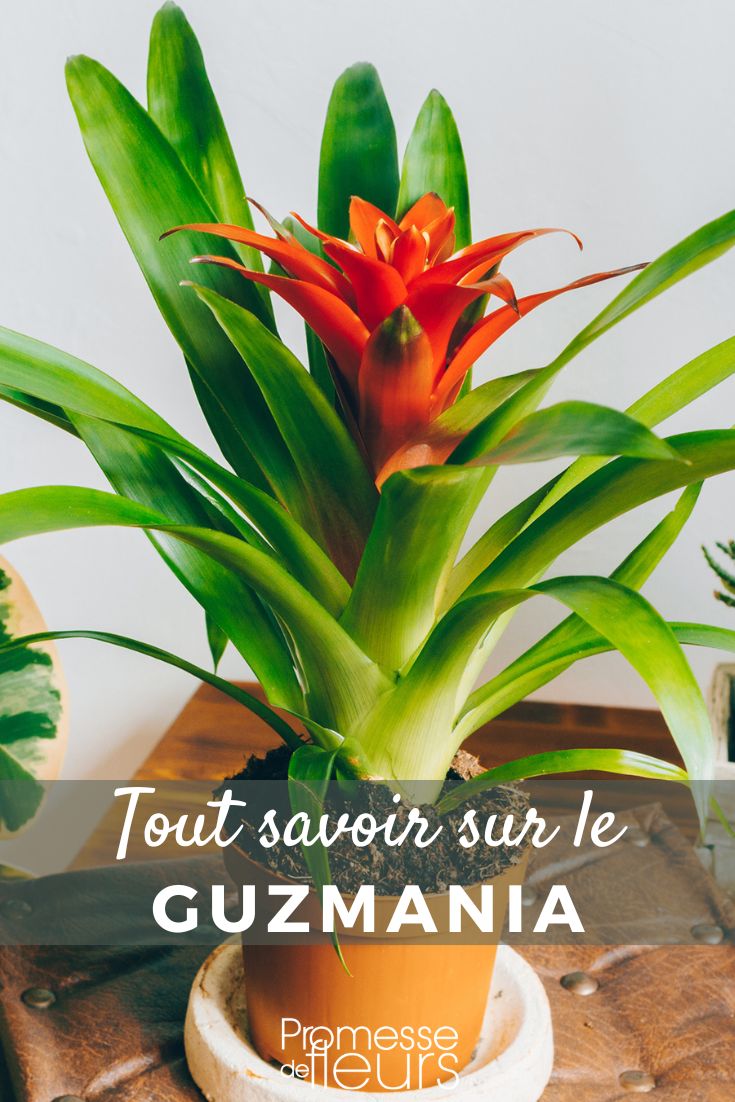































Comments